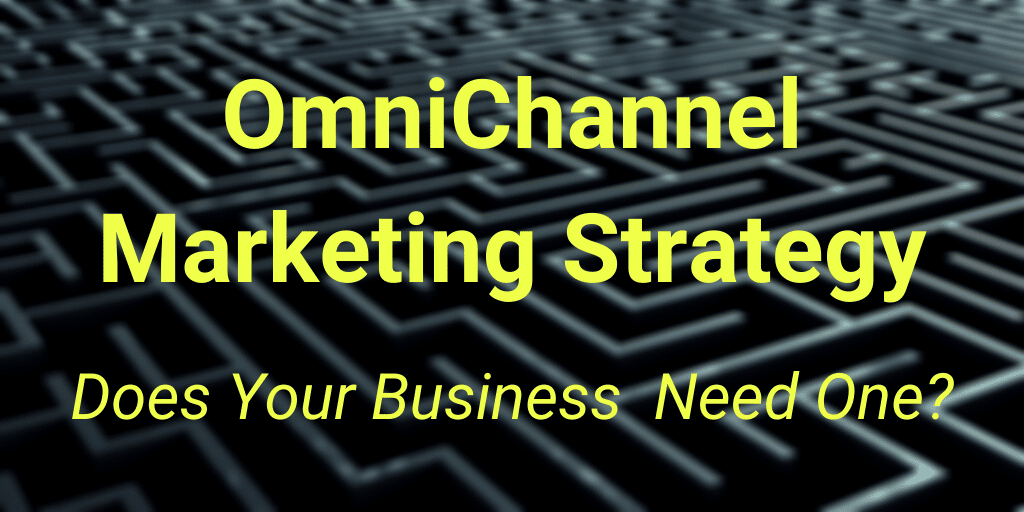eCommerce marketing and selling continues to evolve rapidly.
From the days of focusing on a single channel which evolved to a broader multi-channel strategy. Now the online world has expanded to omnichannel marketing.
The evolution of adapting your marketing strategy to please today’s consumers can be increasingly challenging.
Customers have grown accustomed to connecting with brands through multiple channels.
This poses a challenge for small retailers as a website by itself isn’t enough to capture a growing number of customers.
An eCommerce website must be accompanied by other channels, whether that’s selling on online marketplaces such as Amazon, eBay, Walmart or Etsy; a physical retail store front; or a Facebook store.
Why be visible in other channels? Mainly because your customers will expect to find your brand and products in multiple locations. With the additional channels reinforcing each other and enhancing your customer’s buying experience.
More to the Omnichannel Marketing Story
Just adding new channels is not the whole story regarding what customers want today.
Communicating your message across multiple channels a few years ago may have been more than enough. Today you need to do more to stand out in today’s noisy marketplace.
Customers also expect each channel to work in synchrony to optimize and personalize their experience. They want each of your brand’s channels to work together and have consistent appearance, messaging and pricing across your web presence and physical stores.
This consistency will be included in a number of less obvious areas. These can range from:
- the keywords used to describe brands and products
- to search engine optimization (SEO) efforts on websites and online marketplaces
- to the types of content assets utilized in the marketing and sales process.
Omnichannel marketing strategies are designed with this crucial need in mind. As we’ll discuss in a moment, it’s the latest and best way to create an engaging and seamless customer experience.
Campaigns using a single channel are proven to perform worse than campaigns using multiple channels.
According to OmniSend, an omnichannel marketing automation platform:
“We found that over the last year, marketers using three or more channels in any one campaign earned a 287% higher purchase rate than those using a single-channel campaign.” “…the preference for omnichannel campaigns increased by 14.8% since 2018.” (OmniSend)
Ready to embrace a bottom-line changing strategy?
What is An Omnichannel Marketing Strategy
Omnichannel vs. multi-channel marketing
Let’s kill two birds with one stone and explain this strategy by comparing it to its older “version” – multi-channel marketing. Both start in the same place – your brand and products being being available across multiple channels to let customers connect from any device through their preferred method.
Omnichannel marketing strategies take this one step further and is able to track a customers’ behavior across each channel to create a unified, personalized experience that adjusts specifically to the customer.
This experience is based on relevant elements such as their position in the buyer’s journey, or the products they’re likely interested in according to their behavior. The combined sales and marketing channels are viewed as one entity.
Every channel works synchronisticly, exchanging information about each customer to display the best results. For example, if a customer opens up the page of a product they’re interested in on your website, an ad showcasing similar products shows up as they scroll down their Facebook feed.
Omnichannel selling is the perfect strategy in today’s world to increase click-through rates, conversions, and – to keep it straightforward – your company’s bottom line.
In the retail channel, omnichannel also means taking advantage of both digital and physical stores, to optimize how they best work together.
It’s important to note that each business will have an individual approach to omnichannel. Goals, budget, staff, and other resources will impact the extent to which a business develops and implements this type of sales and marketing strategy.
For example, some small retailers can’t afford a physical store and will have to stick to a digital only presence. They may also have to skip more advanced technologies such as chatbots that customize their answers based on complex sets of data gathered from multiple channels.
Build your brand with as many omnichannel elements as possible, but know that it’s impossible to implement it to the same degree as multi-billion dollar retailers such as Amazon, Walmart or Best Buy.
Related: Ecommerce Business Trademarks – What You Need to Know
The Growth of eCommerce and Omnichannel Selling
More than ever, brands are adapting their experience to be unified across their channels. This is in large part due to the higher availability of options to track customer behavior and the shift in expectations from customers.
Brands are strategically changing to give these customers better results through omnichannel marketing and to get better sales results from their efforts.
But omnichannel selling wasn’t as much of a priority a few years ago when multi-channel was more common. When millennials ruled the marketplace, online retail wasn’t as popular as it is now. Additionally, many ecommerce standards were lower, technology wasn’t as advanced, customers were more patient, and many weren’t as familiar with e-commerce.
But a younger generation, Generation Z, is becoming a larger consumer segment with each passing day. And they don’t behave like older generations when interacting with brands.
Gen Z is currently between 10-25 years old, and as they grow, enter the workforce and graduate from college, their spending power also grows. While older generations spend significant amounts of money shopping online, Generation Z spends even more – boosting the levels of ecommerce shopping.
“Generation Z and online shopping go together like two pieces of a puzzle”
First, let’s just acknowledge they are obsessed with technology and smartphones in many ways. Since they were very young they’ve been exposed to omnichannel brands to the point where they crave them.
But this doesn’t mean that millennials or older generations prefer multi-channel marketing. It just means that a few years ago, before Generation Z was impacting ecommerce trends, brands didn’t really have to change their strategies to thrive.
Times have changed. If your brand hasn’t developed and implemented an omnichannel approach yet it should be the top item on your marketing To Do list.
Reasons to take an omnichannel approach in retail
Increase conversions and stop guessing
By tracking customer behavior across your channels, you get a good idea of their preferences, what kind of products they’re likely to purchase, and their stage in the buying cycle.
With all of this data in hand, you can provide content and products that are more likely to convert – and cut the guessing.
Physical and digital channels feed each other
With an omnichannel approach, your channels feed each other’s success.
For example, when customers try and touch a product in a brick-and-mortar store and later end up deciding to purchase it online.
This example should be easy to visualize, but it barely scratches the surface regarding the effective feedback mechanisms that an omni-channel approach creates.
First and foremost you are there, where your customers most like to purchase.
According to research done by eCommerce platform BigCommerce, “The top three buying destinations for consumers are Amazon, branded ecommerce websites and brick-and-mortar stores.” (Bigcommerce)
Common logic tells us that being everywhere customers are likely to purchase can’t be a bad thing. Even if all the traffic to your products comes from your website, having products available and visible on a marketplace such as Amazon can still increase your revenue and brand visibility.
Some customers may prefer to purchase products on Amazon instead of a business’ website because of a lower price or faster shipping. For some shoppers it may simply be because that’s what they’re used to and where they prefer to shop. Let the customer decide.
Your brand won’t be instantly dismissed
Gen Z grew accustomed to a seamless experience that combines speed, convenience, and customization. Unlike their older counterparts, they are quick to notice any sort of unresponsiveness, unprofessionalism, or old-fashioned elements (such as a purely multi-channel or single-channel experience) in your digital channels.
When this occurs, they are tech-savvy enough to google your competitor in a matter of seconds.
And pleasing them can be tricky – as their brand interaction standards are inflated thanks to multi-billion dollar retailers with outstanding customer service like Amazon.
Omnichannel Marketing and Selling Is The Future
Omnichannel marketing strategies are the future of retail and ecommerce. And with each passing day, their implementation becomes more and more important for retailers.
It is also important to note that implementing an omnichannel strategy is becoming easier. New digital marketing and ecommerce tools and services continue to become available that help speed implementation and increase ROI.
If your brand is craving higher engagement rates, a better customer experience, and customers that come back again and again, an omnichannel approach should be a high priority.
It’s time to adapt. Will your brand fall behind? Or will it learn what it takes to thrive in today’s landscape?
HANDPICKED RELATED CONTENT from Web Presence Solutions
Selling on Amazon – 9 Planning Tips



